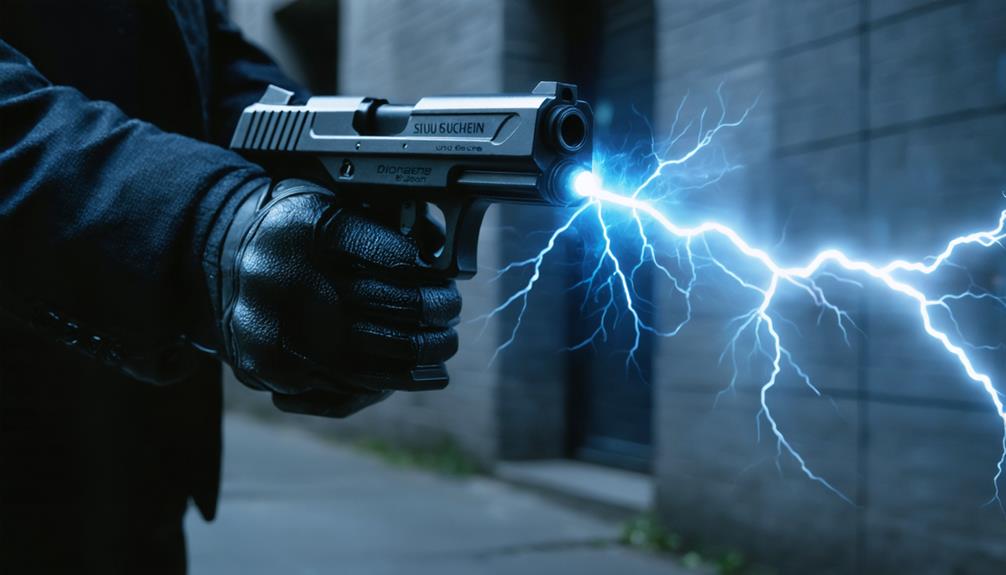
Brainstorm Security Shop

For Orders Over $199

On Any Of Our Products

Details On Refund Page
When you think about self-defense tools, the automatic baton might not be the first thing that comes to mind, yet it offers unique advantages. This compact device extends with a simple push, giving you an edge in tense situations. Its sturdy construction means you can rely on it when you need protection, but there are also important factors to consider, from safety features to legal implications. Understanding these aspects could make a significant difference in how you approach personal security—so what should you know before making your choice?
What exactly is an automatic baton? It’s a self-defense tool that extends with the push of a button, making it quick and easy to deploy in urgent situations. Unlike traditional batons, which require manual effort to extend, automatic batons offer a seamless transition from compact to full length, allowing you to react swiftly when it matters most.
These tools are often made from durable materials like aluminum or steel, ensuring they can withstand impact while remaining lightweight for ease of carry. You might notice that law enforcement use automatic batons as part of their standard equipment, providing officers with an effective means of controlling situations without resorting to lethal force. The design allows for a non-lethal response, making it a preferred choice in various scenarios.
In addition to law enforcement, many civilians turn to automatic batons for personal security. Their compact size makes them easy to store in a bag or car, ready for use when needed. With their ability to deliver a powerful, immediate response, automatic batons stand out as a practical choice for anyone looking to enhance their self-defense options.
Using an automatic baton offers several advantages that make it a smart choice for self-defense. When you consider self-defense tactics, an automatic baton stands out due to its ease of use and effectiveness. Here are some key benefits:
Before using your automatic baton, it’s crucial to prioritize safety precautions to protect yourself and others. Once you’re ready, mastering the proper activation technique will ensure you can deploy it effectively when needed. Let’s look at these key aspects to help you use your baton confidently.
When it comes to handling an automatic baton, prioritizing safety is crucial. Knowing how to use your device properly not only protects you but also those around you. Here are some key safety precautions to keep in mind:
Mastering your automatic baton’s activation technique is essential for effective and safe use. To begin, ensure you have a firm grip on the baton. Your grip strength plays a crucial role in maintaining control during activation. A loose grip can lead to mishaps, so practice holding the baton with confidence.
Next, focus on activation speed. You want to activate the baton swiftly, but don’t rush it. A smooth, quick motion is key to deploying the baton effectively. Practice pressing the activation button with enough pressure to ensure it engages, but not so hard that you risk losing control of the baton.
When you’re ready to activate, position the baton at a comfortable angle, ideally at waist height, to allow for quick deployment. This positioning can help with both speed and precision.
Lastly, always practice in a safe environment to build muscle memory and confidence in your technique. By refining your grip strength and activation speed, you’ll be prepared to respond effectively when it counts. Regular practice will make the activation process second nature, ensuring you’re ready for any situation.
When choosing an automatic baton, you should prioritize safety features that protect both you and those around you.
Look for models made from impact-resistant materials to ensure durability during use.
Additionally, a reliable safety lock mechanism can prevent accidental deployment, giving you peace of mind.
Choosing the right impact-resistant materials is crucial for ensuring the safety and effectiveness of an automatic baton. You want to make sure it can withstand various conditions and potential impacts. Here are some key materials to consider:
Ensuring your automatic baton is equipped with a reliable safety lock mechanism is essential for preventing accidental deployment during transport or storage. You don’t want it to accidentally spring open when you least expect it. A robust locking mechanism should be easy to engage and disengage, allowing you to maintain control over when the baton is ready for use.
Consider the deployment speed as well; you’ll want a mechanism that allows for a quick response when needed but also ensures safety when it’s not in use. A balance is crucial—if the locking system is too complicated, it could slow you down in an emergency.
On the other hand, if it’s too sensitive, you risk it deploying unintentionally.
When choosing your automatic baton, look for features like a dual-locking system or a safety switch that requires intentional action to release. These enhancements can make all the difference in ensuring your baton remains secure until you need it.
Before purchasing an automatic baton, it’s crucial to understand the legal considerations surrounding its use. Different states and countries have varying self-defense laws and legal restrictions that could impact your ability to carry or use an automatic baton. Ignoring these laws can lead to serious legal consequences.
Here are four key points to consider:
Being informed about the laws will help you make responsible choices and ensure you’re prepared for any legal implications associated with owning an automatic baton.
Proper maintenance and care are essential for ensuring the longevity and reliability of your automatic baton. Start by following the cleaning instructions carefully. Use a soft, damp cloth to wipe the exterior regularly, removing dirt and grime that can accumulate. Avoid harsh chemicals; instead, opt for mild soap if necessary. Make sure to dry it thoroughly to prevent moisture buildup, which can lead to corrosion.
When it comes to storage tips, always keep your baton in a dry, cool place. Avoid leaving it in direct sunlight or extreme temperatures, as this can compromise its mechanisms. Consider using a protective sheath or case for added safety, especially if you’re transporting it.
Additionally, inspect your baton periodically for any signs of wear or damage. If you notice anything unusual, address it immediately to prevent further issues.
You need to consider the legal implications of self-defense tools in your area. Assess their effectiveness based on the situation, as not all scenarios justify their use, and legality can vary significantly. Stay informed.
When considering accessibility concerns, automatic batons might not be suitable for individuals with limited strength. Their effectiveness for seniors can vary, so it’s essential to assess personal comfort and confidence before relying on them for self-defense.
When considering materials for self-defense tools, you’ll typically find steel and aluminum. Steel offers durability, while aluminum helps reduce weight, making it easier for you to manage within your strength limitations.
When comparing batons, you’ll notice the weight difference; automatic ones are generally lighter. As for durability, automatic models often use sturdier materials, making them more resilient under stress compared to traditional batons.
Yes, you can explore customization options and personalized designs for your baton. However, keep in mind the legal restrictions and training requirements that may apply in your area before making any modifications.
